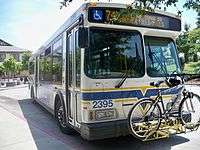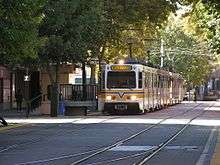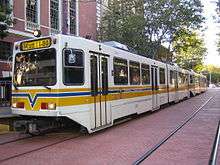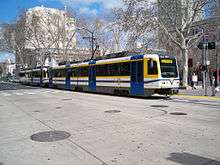Sacramento Regional Transit District
 | |
| Founded | April 1, 1973[1] |
|---|---|
| Headquarters | 1225 R Street |
| Locale | Sacramento, California |
| Service area | Sacramento and Sacramento County |
| Service type | Bus and Light rail |
| Routes |
67 (bus)[1] 3 (light rail) |
| Stops | >3,300 (bus)[1] |
| Hubs |
31 transfer centers 18 park and ride lots[1] |
| Stations | 53 [1] (14 Planned Future Stations and 4 Optional) |
| Fleet |
229 buses[1] 76 active LRVs[1] |
| Annual ridership | 31.5 million (2012)[2] |
| Fuel type | CNG, Diesel-electric hybrid |
| Operator | RT |
| Website | Sacramento Regional Transit District |
The Sacramento Regional Transit District, commonly referred to as RT, is the agency responsible for public transportation in the Sacramento, California area. It was established on April 1, 1973,[1] as a result of the acquisition of the Sacramento Transit Authority. In addition to operating over 60 bus routes with connecting bus service in the Sacramento area covering 418 sq mi (1,082.6 km2),[1] RT also operates a large light rail system. It is currently the eleventh busiest light rail system in the United States.[3]
In addition to the city of Sacramento, RT serves much of the northern portion of Sacramento County which includes the incorporated cities of Citrus Heights and Rancho Cordova. The unincorporated areas of Sacramento County under the RT service area include Arden Arcade, Carmichael, Fair Oaks, Florin, Gold River, North Highlands, Orangevale, Rio Linda and Rosemont.[4] The system formerly provided express bus service between Downtown Sacramento and Elk Grove until the mid-2000s when that city took over bus operations under the newly created E-tran. It also provided contracted bus service to neighboring Yolo County (covering West Sacramento, Davis and Woodland); those routes and operations were later taken over by Yolobus after its formation on January 3, 1982.[5] In both cases, e-tran and Yolobus have retained the RT assigned route numbers for their routes as they continue to service Downtown Sacramento.
History
RT began operations on April 1, 1973, with the acquisition of the Sacramento Transit Authority. Later that year RT completed a new maintenance facility and purchased 103 buses.
Over the next decade RT continued to expand bus service to the growing Sacramento Region while a cooperative effort emerged among city, county and state government officials to develop a light rail system. In 1987 the 18.3-mile (29.5 km) light rail “starter line” opened, linking the northeastern (Interstate 80) and eastern (Highway 50) corridors with Downtown Sacramento. As light rail ridership increased, RT continued to expand the light rail system. RT completed its first light rail expansion along the Highway 50 corridor in September 1998 with the opening of the Mather Field/Mills Station. Five years later (September 2003) RT opened the first phase of the South Line, a 6.3-mile (10.1 km) extension to South Sacramento. In June 2004, light rail was extended from the Mather Field/Mills station to Sunrise Boulevard, and on October 15, 2005 a 7.4-mile (11.9 km) extension from the Sunrise station to the city of Folsom was opened.
In December 2006, the final leg of the Amtrak/Folsom project was extended .7-mile (1.1 km) to the downtown Sacramento Valley Station, connecting light rail with Amtrak inter-city and Capitol Corridor services as well as local and commuter buses. Within the next several years, RT plans to extend light rail beyond Meadowview in South Sacramento to Cosumnes River College and north to Sacramento International Airport. RT currently operates 97 bus routes in a 418-square-mile (1,080 km2) service area.
RT is governed by an eleven-member Board of Directors composed of members of the Sacramento, Elk Grove, Citrus Heights, Rancho Cordova, and Folsom City Councils as well as members of the Sacramento County Board of Supervisors. The fiscal year 2006 operating budget is $148.54 million, with a capital budget of $15.4 million.
RT employs a work force of approximately 1,163 people, 80% of whom are dedicated to operations and maintenance of the bus and light rail systems. RT operates three maintenance and operations facilities – one for buses at 29th and N Streets, one for the Community Bus Service at McClellan Park, and one for the light rail system at 2700 Academy Way in North Sacramento.
Fares
| Group | Fare Type | Single | Daily Pass | Monthly Pass |
|---|---|---|---|---|
| 19-61 | Basic | $2.50 | $6 | $100 |
| Student (5-18) | Discount | $1.25 | $3 | $50 |
| Disabled | Discount | $1.25 | $3 | $50 |
| Senior 62+ | Discount | $1.25 | $3 | $50 |
| Super Senior 75+ | Discount | Senior Fare | Senior Fare | $40 |
PrePaid ticket books
PrePaid tickets are sold in books of ten.
| Group | Fare Type | Single | Daily Pass |
|---|---|---|---|
| 19-61 | Basic | $25 | $60 |
| Senior 62+ | Discount | $12.50 | $30 |
| Disabled | Discount | $12.50 | $30 |
| Student (5-18) | Discount | $12.50 | $30 |
Class Pass
Regional Transit also offers the Class Pass for use during 9am-3:30pm. For any group of 10 or more students that are pursuing a high school diploma the cost is $2.50 per student and $5 for each adult.

Bus service
Since 2004, with the exception of some neighborhood shuttle vans (see #The Neighborhood Ride below), the bus fleet consists exclusively of Orion 07.501 (VII) and Orion VII Next Generation buses powered by compressed natural gas. In 2015 RT will add a fleet of Gillig BRT Plus CNG to the lineup to replace buses that reached its 12-year run.
The RT system operates 67 bus routes, as of 2013, with service between 5:00 a.m. and 11:00 p.m. daily, and ending much earlier on weekends. Frequencies range between every 15 and 80 minutes (some express buses run only a few times a day). There has been proposals in the past to expand the service hours to late nights to accommodate passengers, businesses and communities, but have been slow to implement these ideas. The most recent changes were announced in August 2012, and is gradually making plans to improve and expand bus services system-wide by 2017.[6] Since light rail has opened, buses have generally acted as feeders to light rail routes.
The RT system does not provide service to Sacramento International Airport. Service between downtown Sacramento and the airport is instead provided on an hourly basis by the Yolobus system.[7]
Bus fleet (FY2010)
- 216 buses
- 17 shuttle vans
- 1 Holiday Bus
- 233 Total
| Fleet Number Range | Thumbnail | Year | Manufacturer | Model Number | Engine | Transmission | Notes |
|---|---|---|---|---|---|---|---|
| 1966 | GMC | TDH-4519 |
| ||||
| 1967 | GMC | TDH-4519 |
| ||||
| 1968 | GMC | T6H-4521A |
| ||||
| 1969 | GMC | T6H-4521A |
| ||||
| 1-2 | 1969 | Western Flyer | D700A |
| |||
| 91-94 | 1967 | Western Flyer | D700 |
| |||
| 101-115 | 1956 | GMC | TDH-4512 | Ex-Sacramento Transit Authority 116-120. | |||
| 116-120 | 1957 | GMC | TDH-4512 | Ex-Sacramento Transit Authority 116-120. | |||
| 121-130 | 1958 | GMC | TDH-4512 |
| |||
| 131-135 | 1960 | GMC | TDH-4517 | Ex-Sacramento Transit Authority 131-135. | |||
| 136-140 | 1961 | GMC | TDH-4517 | Ex-Sacramento Transit Authority 136-140. | |||
| 141-145 | 1962 | GMC | TDH-4517 |
| |||
| 203 | 1966 | GMC | SDM-4502 |
| |||
| 204-206 | 1969 | GMC | S6H-4503A |
| |||
| 251-252 | 1966 | GMC | TDH-4519 |
| |||
| 301-305 | 1963 | GMC | TDH-4519 |
| |||
| 306-310 | 1964 | GMC | TDH-4519 |
| |||
| 311-315 | 1965 | GMC | TDH-4519 |
| |||
| 316-323 | 1966 | GMC | TDH-4519 |
| |||
| 324-325 | 1966 | GMC | TDH-4519 |
| |||
| 401-415 | 1968 | GMC | T6H-4521A | Ex-Sacramento Transit Authority 401-415. | |||
| 2001-2012 | 2000 | OBI | Orion 05.501 CNG | Cummins LTA-10G | ZF 4HP590 |
| |
| 2051-2054 | 2000 | Optima | American Heritage Streetcar CNG | ||||
| 2301-2398, 2401-2408 | 2002-03 | OBI | Orion 07.501 CNG | Cummins C Gas Plus | ZF HP592C |
| |
| 2601-2605 | 2006 | OBI | Orion 07.501 CNG | Cummins C Gas Plus | ZF HP592C | ||
| 2651-2653 | 2006 | ElDorado National | MST II | ||||
| 2701-2702 | 2007 | Ford/Starcraft | E450 Starlite | ||||
| 2801-2891 | 2008 | OBI | Orion 07.501 NG CNG | Cummins ISL G | ZF HP592C | ||
| 2901-2912 | 2009 | Ford/Starcraft | E450 Starlite | ||||
| 4150-4174 | 1975 | Flxible | 45102-8-1 |
| |||
| 4700-4722 | 1983 | Gillig | Phantom (4096TA) | Detroit Diesel 6V92TA | |||
| 4723-4749 | 1985 | Gillig | Phantom (40102TB) | Detroit Diesel 6V92TA | |||
| 4900-4921 | 1973 | Flxible | 111CC-D06-1 | ||||
| 5150-5160 | 1962 | GMC | TDH-5301 |
| |||
| 5306-5310 | 1963 | GMC | TDH-5303 |
| |||
| 5501-5506 | 1947 | GMC | TDH-4507 |
| |||
| 5507-5508 | 1948 | GMC | TDH-4507 |
| |||
| 5509-5510 | 1946 | GMC | TD-4506 |
| |||
| 9001-9050 | 1990 | Gillig | Phantom (40102TB) | Detroit Diesel 6V92TA |
| ||
| 9301-9375 | 1993-94 | OBI | Orion 05.501 CNG | Cummins LTA-10G | ZF 4HP590 |
| |
| 9401-9420 | 1994 | OBI | Orion 05.501 CNG | Cummins LTA-10G | ZF 4HP590 |
| |
| 9601-9626 | 1996-97 | OBI | Orion 05.501 CNG | Cummins LTA-10G | ZF 4HP590 | ||
| 9651-9665 | 1996 | OBI | Orion 05.505 CNG | Cummins LTA-10G | ZF 4HP590 |
Most popular bus routes
The numbers provided are average weekday boardings.
Transit centers
| Transit Center | Location | Bike lockers | Transfers |
|---|---|---|---|
| American River College | Location | No | 1, 82 |
| Arden Fair Mall | Location | No | 22, 23, 29, 67, 68 |
| Cosumnes River College | Location | No | 54, 55, 56 |
| CSUS | Location | No | 30, 31, 34, 82, 87 |
| Florin Mall | Location | No | 47, 51, 55, 67, 68, 81 |
| Sunrise Mall | Location | No | 1, 21, 23, 24, 25, 28 |
| Louis and Orlando | Location | No | Sacramento Regional Transit 21, 93, and 103 Roseville Transit A, B, R, and Commuter Placer County Transit to Auburn, CA |
Light rail
|
A Siemens Duewag U2A in downtown Sacramento | |||
| Overview | |||
|---|---|---|---|
| Locale | Sacramento, CA | ||
| Transit type | Light rail | ||
| Number of lines | 3 | ||
| Number of stations | 54[1] | ||
| Daily ridership |
48,400 average weekday riders (Q1 2013)[3] | ||
| Annual ridership | 13.873 million (2012)[2] | ||
| Website | Sacramento Regional Transit District | ||
| Operation | |||
| Began operation | March 12, 1987[9] | ||
| Operator(s) | Sacramento Regional Transit District | ||
| Number of vehicles |
36 Siemens-Duewag U2A vehicles and 40 CAF Class 200 vehicles[9] | ||
| Technical | |||
| System length | 42.9 mi (69.0 km)[1] | ||
| Track gauge | 1,435 mm (4 ft 8 1⁄2 in) (standard gauge) | ||
| Electrification | Overhead lines, 750 V DC | ||
| |||
The Sacramento RT Light Rail system (reporting mark SCRT) is a 42.9 mi (69.0 km)[1] system, consisting of three rail lines, 54 stations, and 76 vehicles. The LRV fleet consists of Siemens-Duewag U2A vehicles, which have been in use since the light rail's inception, and more modern CAF trains delivered in 2003.[9]
Before the June 2010 budget cuts, RT light rail formerly operated from 4:30 a.m. to 1 a.m. daily with 15 minute headways during the day. After the budget cuts took place, light rail service was curtailed to operate from 4:30 a.m. to 10 p.m. daily, with service every 15 minutes Monday through Friday, and every 30 minutes on weekends and at night. In 2013, RT light rail service was restored to operate more hours again, now operating from 4:30 a.m. to 12:30 a.m.
Sacramento's light rail system, with an average of 48,400 weekday daily boardings in Q1 2013,[3] is the eleventh busiest in the United States.
The creation and maintenance of the light-rail system is pushed by the advocacy group Friends of Light Rail and Transit.
Most popular light rail stations
Numbers provided are average weekday "on & offs":
Blue Line – Watt/I-80–Downtown–Cosumnes River College Line
Gold Line – Downtown–Sunrise Folsom Line
Green Line – Downtown–Township 9

Future projects
Future plans include extending the Green Line to the Sacramento International Airport via the neighborhood of Natomas.[10] A planned extension to Roseville, once a top priority, has been on hold for years. Extensions to Elk Grove, Roseville, and Citrus Heights are part of the Sacramento Regional Transit Master Plan, adopted by RT in September 2009.[11]
Green Line future extension project
The 'Green Line to Sacramento International Airport (SMF) light rail future extension Project' / The line will extends 12 miles (19.3 km).
Future new Green Line stations, South to Northwest from the existing 7th & Richards/Township 9 Station, are:
- Sequoia Pacific Station (Optional)
- West El Camino Station
- Pebblestone Way Station
- San Juan Station
- Gateway Park Station
- Arena Blvd. Station
- -N/A (Station Name Coming Soon) N/A-
- East Town Center Station
- North Natomas Town Center Station
- Commerce Parkway Station (Optional)
- Club Center Drive Station
- Greenbriar Station (Optional)
- Metro Air Park Station (Optional)
- Sacramento International Airport -SMF- Station
Blue Line extension project
The 'Blue Line to Cosumnes River College light rail extension Project' – the second phase in the South Sacramento Corridor Study – commenced construction in 2011.[12][13][14] The first phase of this study (Downtown Sacramento to Meadowview Road) has been completed and is operating.[12] Both Blue Line extensions are component in the 10-year Rail Development Plan for a new light rail corridor in the South Sacramento area.[12] In August 2015, the 4.3 miles (6.9 km) extension opened, with a final cost of $260 million.[15] 11,000 riders are expected to use the new stations daily. The project extended the Blue Line south to a new Cosumnes River College—CRC terminus.[12]
New Blue Line stations, north to south from the existing Meadowview Station, are:[16]
- Morrison Creek Station
- Franklin Station
- Center Parkway Station
- Cosumnes River College Station
Planning issues
The line currently ends at the college in response to the Federal Transit Administration (FTA) land use, station accessibility, and federal grants needs. Other changes include: a new station at Morrison Creek (half-way between Meadowview and Franklin); improved pedestrian access to Franklin and Center Parkway stations; and a 2000 car parking structure, replacing previously planned surface parking, at Cosumnes River College.[12][17][18]
California's ongoing financial crisis also contributed to the decision to terminate the Blue Line extension project at Cosumnes River College. Expansion to Elk Grove is covered in the TransitAction Plan, which is tied to the SACOG Blueprint, and a schedule has yet to be determined.[12][18]
Paratransit
To meet the requirements of the 1990 Americans with Disabilities Act, the RT established a Paratransit service in 1993, which is a door-to-door service for the disabled.
The Neighborhood Ride
In 2006, RT created a new division internally known as "Community Bus Service". Known to the ridership as "The Neighborhood Ride"

- The Neighborhood Ride shuttles are smaller buses (approximately 35 feet (11 m) or less in length) that offer residents greater mobility and new transit options on local intra-community trips.
- The Neighborhood Ride shuttles have regular, pre-designated, pre-scheduled routes, but offer special curb-to-curb service (not to be confused with ADA/paratransit door-to-door service). The shuttles are able to "deviate" travel off route up to ¾ of a mile to pick up and drop off seniors, age 62 and older, and disabled passengers who have a valid ADA/paratransit pass
- Passengers pay only $1.10 per trip (55 cents for passengers paying a discount fare). RT monthly passes, daily passes, and transfers are also accepted. Passengers with valid ADA/paratransit passes ride free.
- All passengers (except for Lifetime Pass holders), including those with valid ADA/paratransit passes, must pay an additional $1.10 for a route deviation.
- Marked bus stops are located along the route and printed schedules are available at several locations around Sacramento and on Regional Transit's Web site.
- Each shuttle can transport 12-17 passengers and up to two wheelchairs.
Fleet images
-
Archives Plaza Station
-
CAF LRV at Archives Plaza Station
-

A CAF LRV Interior
-
A Watt/I-80 Bound
-

A Watt/I-80 Bound
-

A Siemens Duewag U2A bound for Downtown at Sacramento Valley Station
-

Orion V
-

Orion VII Next Generation
-

Tourist trolleys
-

Sacramento Transit Bus at Mather Field/Mills LRT Station
-

Siemens Duewag U2A Interior
Accidents and incidents
On April 9, 2010 at about 10:20 a.m. a Blue Line train struck a vehicle at the 47th Ave. crossing. The vehicle, a green Honda Accord was dragged about 100 feet (30 m). Inside the vehicle was a woman about the age of 40, She was pronounced dead at U.C. Davis Medical Center. The cause was revealed to be the woman who drove her car around the crossing gates which were down.
A man was hospitalized April 26, 2010 after he was hit by a light rail while talking on a cell phone.The crash happened near the Iron Point Station in Folsom at about 10 a.m. Investigators said the pedestrian was walking on the tracks and not paying attention to what was coming toward him. The pedestrian on the tracks never looked up at all throughout the entire incident. The operator told investigators that he had spoken to the injured person, and the guy said that he was walking on the tracks because he didn't want to be walking on the roadway while talking on his cell phone. The pedestrian was in serious condition at UC Davis Medical Center. Passengers on the train had an hour delay.
Deputies were called shortly after 9 a.m. on April 27, 2010 to the Zinfandel station. Sheriff's Sgt. Tim Curran said one person shot the victim in the leg and then fled. Investigators said a fight broke out on a light rail train, culminating in a shooting once the train reached the station platform. The alleged shooter was seen running across the parking lot outside a nearby Ross store, Curran said. The victim was expected to survive, authorities said. RT service did not appear to be affected.
On November 11, 2010 a pick up truck ran into the side of a moving Regional Transit Light Rail Train at 10:15 a.m. at Starfire Drive and Folsom Boulevard in Sacramento County. The train was only scratched in the collision. Only one passenger received medical attention for minor injuries; the two people in the truck were not hurt.
A Siemens light rail vehicle on a Gold Line train caught fire and started to smoke on December 23, 2010 at approximately 7:30 p.m. near the College Greens station. A communications issue between the Sacramento Fire Department and the Regional Transit light rail operator occurred when the train began to move from the station where the fire was being doused to the Watt/Manlove station over a mile away. The fire caused service disruptions to Gold Line trains traveling in both directions for up to an hour. The car (#136) was towed out of service to the Regional Transit maintenance facility on Academy Way. The fire was likely caused by an overheated generator and battery located on the bottom of the train.
On January 28, 2012 three people died after their vehicle collided with a light rail train. The accident took place at the crossing near the intersection of 25th Street and 26th Avenue just before 4:45 p.m, when black Pathfinder SUV was hit by a southbound Blue Line train. The gate arms were determined to be functioning properly. All three fatalities were occupants of the vehicle. At least 17 injured victims were taken to the hospital for treatment.
See also
- List of rapid transit systems
- Light rail in North America
- Light Rail
- Roseville Transit
- Placer County Transit
References
- 1 2 3 4 5 6 7 8 9 10 11 12 13 14 15 "RT Fact Sheet" (pdf). Sacramento Regional Transit District. June 2015. Retrieved 2015-09-09.
- 1 2 "APTA Ridership Report - Q4 2012 Report" (PDF). American Public Transportation Association (APTA) (via: http://www.apta.com/resources/statistics/Pages/RidershipArchives.aspx). March 2013. Retrieved 2013-07-13. External link in
|publisher=(help) - 1 2 3 "APTA Ridership Report - Q1 2013 Report" (PDF). American Public Transportation Association (APTA) (via: http://www.apta.com/resources/statistics/Pages/ridershipreport.aspx). May 2013. Retrieved 2013-06-22. External link in
|publisher=(help) - ↑ "System Map - Sacramento Regional Transit". Sacramento Regional Transit District. Retrieved 2013-07-30.
- ↑ YOLOBUS To Turn 30! from Yolobus (October 2011)
- ↑ "Calif.’s Sacramento RT expands light rail, bus service" from Metro Magazine (August 29, 2012)
- ↑ Yolobus.com Sacramento Airport Routes and Schedules
- 1 2 3 pg6 RT Fact Sheets - Sacramento Regional Transit
- 1 2 3 "Sacramento Regional Transit Light Rail FACT SHEET" (pdf). Sacramento Regional Transit Light Rail. February 2008. Retrieved 2007-01-23.
- ↑ Sacramento RT website: "Green Line to the Airport"
- ↑ "Sacramento TransitAction Regional Transit Master Plan: Executive Summary" (PDF). Sacramento Regional Transit District. Retrieved 13 January 2015.
- 1 2 3 4 5 6 "Information Center - Blue Line". Sacramento Regional Transit District. Retrieved 2013-07-30.
- ↑ "Project Schedule - Blue Line". Sacramento Regional Transit District. Retrieved 2013-07-30.
- ↑ "Current Construction Schedule - Blue Line". Sacramento Regional Transit District. Retrieved 2013-07-30.
- ↑ Bizjak, Tony (August 24, 2015). "Transit advocates, riders celebrate opening of light rail’s south line". The Sacramento Bee. Retrieved August 26, 2015.
- ↑ "Gallery - Blue Line". Sacramento Regional Transit District. Retrieved 2013-07-30.
- ↑ Official Blue Line extension website: "In order to compete for Federal funding, terminus stations (such as the one proposed at Cosumnes River College) need to provide sufficient parking to claim ridership. A computer model generates the anticipated demand for spaces required at each of the stations. The model calculated a demand of 2,000 spaces for the College." . accessed 4.14.2013
- 1 2 South Sacramento Corridor Phase 2 Project
External links
| Wikimedia Commons has media related to Sacramento Regional Transit District. |
- Sacramento Regional Transit District official website
- Friends of Light Rail, a Sacramento light rail advocacy group
- Sacramento Regional Transit on the Sacramento Wiki
- Pictures of LRT System at NYC Subway
- System Map of the Sacramento Regional Transit
- List of RT bus routes and descriptions
| ||||||||||||||||||||||
| ||||||||||||||||||||||||||||||||||||||||||||||||||||||||||||||||||||||||||||||||||||||||||||||||||||
| |||||||||||||||||||||||||



